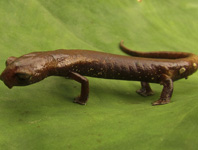Abstract
The Rhinella granulosa group consists of 13 described species with distribution from South America to Panama (Narvaes & Rodrigues 2009; Sanabria et al. 2010; Pereyra et al. 2016). Species belonging to this monophyletic group are characterized by their small to medium body size, ossified skull, small parotoid gland, keratinized cephalic crests and body covered by granules and spicules (Narvaes & Rodrigues 2009; Pereyra et al. 2016). These toads present explosive or prolonged breeding in temporary ponds of open areas (Borteiro et al. 2006; Mercês et al. 2009; Narvaes & Rodrigues 2009; Blotto et al. 2014), where eggs are laid in two long, uniseriate and gelatinous strings (Lima et al. 2012; Blotto et al. 2014; Pereyra et al. 2015). In general, tadpoles of these species are small, round and darkly colored (Blotto et al. 2014). Currently, only seven species have had their tadpoles formally described: Rhinella azarai (Gallardo 1965), Rhinella dorbignyi (Duméril & Bibron 1841), Rhinella fernandezae (Gallardo 1957), Rhinella granulosa (Spix 1824), Rhinella humboldti (Gallardo 1965), Rhinella mirandaribeiroi (Gallardo 1965), and Rhinella pygmaea (Myers & Carvalho 1952) (Fernández 1927; Kenny 1969; Carvalho-e-Silva & Carvalho-e-Silva 1994; Borteiro et al. 2006; Lynch 2006; Mercês et al. 2009; Blotto et al. 2014; Schulze et al. 2015). Pereyra et al. (2016) discussed the taxonomic identity of tadpoles described by Lavilla et al. (2000) as Rhinella major (Müller & Hellmich 1936), and following their concern we do not include these in our comparison. For the Rhinella merianae tadpole, there has been only a brief description (diagrammatic drawings and color patterns in life) in the tadpole identification key from Central Amazonia of Hero (1990) as Bufo granulosus. Therefore, we present in this paper a formal description of the tadpole of R. merianae and additional comments of its clutch size, measurements of eggs and spawning sites.
References
Altig R. & Johnston, G.F. (1989) Guilds of anuran larvae: relationships among developmental modes, morphologies and habitats. Herpetological Monographs, 3, 81–109.
https://doi.org/10.2307/1466987Altig, R. & McDiarmid, R.W. (1999) Body Plan: Development and Morphology. In: McDiarmid, R.W. & Altig, R. (Eds.), Tadpoles: The biology of Anuran Larvae. The University of Chicago Press, Chicago & London, pp. 24–51.
Blotto, B.L., Pereyra, M.O. & Baldo, D. (2014) The tadpole of Rhinella azarai (Gallardo, 1965) with comments on larval morphology in the Rhinella granulosa species group (Anura: Bufonidae). Journal of Herpetology, 48, 434–438.
https://doi.org/10.1670/12-121Borteiro, C., Kolenc, F., Tedros, M. & Prigioni, C. (2006) The tadpole of Chaunus dorbignyi (Duméril & Bibron) (Anura, Bufonidae). Zootaxa, 1308, 49–62.
Carvalho-e-Silva, A.M.P.T. & Carvalho-e-Silva, S.P. (1994) Données sur la biologie et description des larvaes de Bufo pygmaeus Myers et Carvalho (Amphibia, Anura, Bufonidae). Revue Française d’Aquariologie, 21, 53–56.
Fernández, K. (1927) Sobre la biología y reproducción de batracios argentinos. Segunda parte. Boletín Academia Nacional de Ciencias de Córdoba, 29, 271–320.
Gosner, K.L. (1960) A simplified table for staging anuran embryos and larvae with notes on identification. Herpetologica, 16, 183–190.
Hero, J.M. (1990) An illustrated key to tadpoles occurring in the Central Amazon rainforest, Manaus, Amazonas, Brasil. Amazoniana, 11, 201–262.
Hödl, W. (1990) Reproductive diversity in Amazonian lowland frogs. In: Hanke, W. (Ed.), Biology and Physiology of the Amphibians. G. Fischer Verlag, Stuttgart & New York, pp. pp. 41–60.
Kenny, J.S. (1969) The Amphibia of Trinidad. Studies on the Fauna of Curaçao and other Caribbean Islands, 29, 1–78, 15 pls.
Lavilla, E.O., Ponssa, M.L. & Saleme, S. (2000) Caracterización de las larvas de Bufo fernandezae Gallardo, 1957 y Bufo granulosus major Müller & Hellmich, 1936 (Anura: Bufonidae) y clave para la identificación de las larvas de Bufo que habitan el Chaco Argentino. Bollettino del Museo Regionale di Scienze Naturali di Torino, 17, 333–344.
Lima, A.P., Magnusson, W.E., Menin, M., Erdtmann, L.K., Rodrigues, D.J., Keller, C. & Hödl, W. (2012) Guide to the frogs of Reserva Adolpho Ducke, Central Amazonia. 2nd edition. Instituto Nacional de Pesquisas da Amazônia, Manaus, 187 pp.
Lynch, J.D. (2006) The tadpoles of frogs and toads found in the lowlands of Northern Colombia. Revista de la Academia Colombiana de Ciencias Exactas, Físicas y Naturales, 30, 443–457.
Mercês, E.A., Juncá, F.A. & Casal, F.S.C. (2009) Girinos de três espécies do gênero Rhinella Fitzinger, 1826 (Anura -Bufonidae) ocorrentes no estado da Bahia, Brasil. Sitientibus Série Ciências Biológicas, 9, 133–138.
Narvaes, P. & Rodrigues, M.T. (2009) Taxonomic revision of Rhinella granulosa species group (Amphibia, Anura, Bufonidae), with a description of a new species. Arquivos de Zoologia, 40, 1–73.
https://doi.org/10.11606/issn.2176-7793.v40i1p1-73Pereyra, M.O., Vera Candioti, M.F., Faivovich, J. & Baldo, D. (2015) Egg clutch structure of Rhinella rumbolli (Anura: Bufonidae), a toad from the Yungas of Argentina, with a review of the reproductive diversity in Rhinella. Salamandra, 51, 161–170.
Pereyra, M.O., Baldo, D., Blotto, B.L., Iglesias, P.P., Thomé, M.T.C., Haddad, C.F.B., Barrio-Amorós, C., Ibáñez, R. & Faivovich, J. (2016) Phylogenetic relationships of toads of the Rhinella granulosa group (Anura: Bufonidae): a molecular perspective with comments on hybridization and introgression. Cladistics, 32, 36–53.
https://doi.org/10.1111/cla.12110Sanabria, E., Quiroga, L., Arias, F. & Cortez, R. (2010) A new species of Rhinella (Anura: Bufonidae) from Ischigualasto Provincial Park, San Juan, Argentina. Zootaxa, 2396, 50–60.
Schulze, A., Jansen, M. & Köhler, G. (2015) Tadpole diversity of Bolivia's lowland anuran communities: molecular identification, morphological characterisation, and ecological assignment. Zootaxa, 4016 (1), 1–111.
https://doi.org/10.11646/zootaxa.4016.1.1

